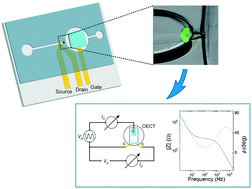Our official English website, www.x-mol.net, welcomes your feedback! (Note: you will need to create a separate account there.)
A planar impedance sensor for 3D spheroids†
Lab on a Chip ( IF 6.1 ) Pub Date : 2018-02-15 00:00:00 , DOI: 10.1039/c8lc00067k V. F. Curto 1, 2, 3, 4, 5 , M. P. Ferro 1, 2, 3, 4, 5 , F. Mariani 6, 7, 8, 9 , E. Scavetta 6, 7, 8, 9 , R. M. Owens 1, 2, 3, 4, 5
Lab on a Chip ( IF 6.1 ) Pub Date : 2018-02-15 00:00:00 , DOI: 10.1039/c8lc00067k V. F. Curto 1, 2, 3, 4, 5 , M. P. Ferro 1, 2, 3, 4, 5 , F. Mariani 6, 7, 8, 9 , E. Scavetta 6, 7, 8, 9 , R. M. Owens 1, 2, 3, 4, 5
Affiliation

|
Three dimensional cell culture systems have witnessed rapid expansion in the fields of tissue engineering and drug testing owing to their inherent ability to mimic native tissue microenvironments. High throughput technologies have also facilitated rapid and reproducible generation of spheroids and subsequently their use as in vitro tissue models in drug screening platforms. However, drug screening technologies are in need of monitoring platforms to study these 3D culture models. In this work we present a novel platform to measure the electrical impedance of 3D spheroids, through the use of a planar organic electrochemical transistor (OECT) and a novel circular-shaped microtrap. A new strategy was generated to overcome incompatibility of the integration of polydimethylsiloxane (PDMS) microdevices with OECT fabrication. The impedance platform for 3D spheroids was tested by using spheroids formed from mono-cultures of fibroblast and epithelial cells, as well as co-culture of the two cell types. We validated the platform by showing its ability to measure the spheroid resistance (Rsph) of the 3D spheroids and differences in Rsph were found to be related to the ion permeability of the spheroid. Additionally, we showed the potential use of the platform for the on-line Rsph monitoring when a co-culture spheroid was exposed to a porogenic agent affecting the integrity of the cell membrane.
中文翻译:

用于3D椭球的平面阻抗传感器†
三维细胞培养系统因其固有的模仿天然组织微环境的能力而在组织工程和药物测试领域迅速发展。高通量技术还促进了球体的快速和可重现生成,以及随后在体外的使用。药物筛选平台中的组织模型。但是,药物筛选技术需要监控平台来研究这些3D培养模型。在这项工作中,我们提出了一个新颖的平台,可通过使用平面有机电化学晶体管(OECT)和新颖的圆形微阱来测量3D球体的电阻抗。产生了一种新的策略来克服聚二甲基硅氧烷(PDMS)微型设备与OECT制造之间的不兼容问题。通过使用由成纤维细胞和上皮细胞的单培养物以及两种细胞类型的共培养物形成的球体来测试3D球体的阻抗平台。我们通过展示其测量3D椭球体的椭球体电阻(R sph)的能力以及其差异来验证该平台发现R sph与球状体的离子渗透性有关。此外,当共培养球体暴露于影响细胞膜完整性的成孔剂时,我们展示了该平台在在线R sph监测中的潜在用途。
更新日期:2018-02-15
中文翻译:

用于3D椭球的平面阻抗传感器†
三维细胞培养系统因其固有的模仿天然组织微环境的能力而在组织工程和药物测试领域迅速发展。高通量技术还促进了球体的快速和可重现生成,以及随后在体外的使用。药物筛选平台中的组织模型。但是,药物筛选技术需要监控平台来研究这些3D培养模型。在这项工作中,我们提出了一个新颖的平台,可通过使用平面有机电化学晶体管(OECT)和新颖的圆形微阱来测量3D球体的电阻抗。产生了一种新的策略来克服聚二甲基硅氧烷(PDMS)微型设备与OECT制造之间的不兼容问题。通过使用由成纤维细胞和上皮细胞的单培养物以及两种细胞类型的共培养物形成的球体来测试3D球体的阻抗平台。我们通过展示其测量3D椭球体的椭球体电阻(R sph)的能力以及其差异来验证该平台发现R sph与球状体的离子渗透性有关。此外,当共培养球体暴露于影响细胞膜完整性的成孔剂时,我们展示了该平台在在线R sph监测中的潜在用途。



























 京公网安备 11010802027423号
京公网安备 11010802027423号